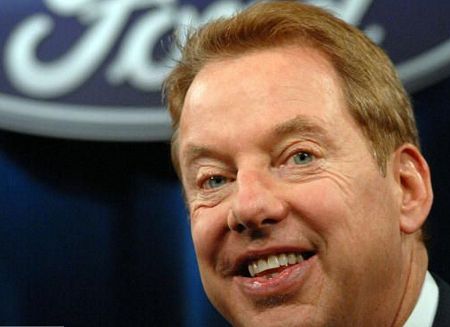
Change is in the air in the world of business. Yesterday, it was announced that Ford is making a change at the top. After just three years with Mark Fields in their corner office, Ford switched horses and named former Steelcase CEO, Jim Hackett, as his replacement.
Bill Ford, Jr., the company’s chairman, explained the move this way to Bloomberg:
“We need to speed up decision making. We live in a world where the clock speed has increased dramatically. We have  competitors now coming into our space that we haven’t seen before. We just need to get ourselves into the fighting shape very very quickly…In a time of great transition – and that’s where we are now – I’ve never seen such a time in our industry where technology, and competitors, and everyting is converging to drive real change. It’s very helpful at a time like that to have a leader experienced in driving transformational change.”
competitors now coming into our space that we haven’t seen before. We just need to get ourselves into the fighting shape very very quickly…In a time of great transition – and that’s where we are now – I’ve never seen such a time in our industry where technology, and competitors, and everyting is converging to drive real change. It’s very helpful at a time like that to have a leader experienced in driving transformational change.”
Change is in the air in the radio industry, too. You can feel it.
As radio’s two biggest companies continue to battle crippling debt, other radio groups are jockeying for position. And with regulation changes in the offing, this could usher in a new era of radio leadership at a time when all traditional media are fighting the forces of disruption and change.
But what are the new skill sets required to run a media company in 2017, 2018, and beyond? As radio CEOs grapple with the change that is all around us – content, disruption, artificial intelligence, and the Internet of Things, a new tool kit will be necessary to cope with this rapidly changing landscape. What role will the medium play in people’s lives, and what qualities will radio’s leaders need in order to effectively compete in a new media ecosystem?
Now a new story in Fast Company by Jared Lindzon provides a modern day CEO checklist, with the proviso that many of the time-honored attributes of corporate leadership no longer apply.
Lindzon suggests that in a world where automation, AI, and robots will become commonplace, new thinking and adapted value systems will be necessary. While traditional metrics like profits, losses, EBITDA, and margins will always be important, a different look at radio organizations and how they operate is necessary in order to succeed in the business world of the not-so-distant future.
Here are his five new required skills, followed by a few of my own, crafted with the radio business in mind:
1. The ability to think of new solutions
For decades, executives executed a strategy. Most of the time, it revolved around controlling expenses, fostering growth, and expanding revenues and profits. But the forces of disruption require more than simply following “the plan.”
Understanding the impact of the changes – the “connected car,” programmatic buying, voice command technology – is now table stakes in moving a company forward rather than being left behind. Being able to understand the promise of new opportunities and how they will impact the industry as well as their companies frames this important skill.
2. Being comfortable with chaos
I like the wording “Get comfortable with being uncomfortable.” The end result is the same. There is very little calm in business these days, and the radio industry is no exception.
As Bill Ford, Jr. noted, everything has to move faster now, and a radio executive who can run and think fast has an edge over the rest of the pack. Part of this skill translates to having a sense of comfort with the craziness, and not being reluctant to blow up operating systems and sacred cows of the past.
3. An understanding of technology
There is no longer an excuse for radio’s leaders to simply not understand how media and technology are changing. Execs that aren’t articulate on a wide range of subjects – from social media to mobile to automotive – can’t effectively make decisions.
Part of this skill stems from a genuine curiosity to learn more about technology, while surrounding themselves with people who have expertise in key areas and disciplines. This might include corporate staffers or board members who “get it” and can share their knowledge and experience.
The importance of smart, trustworthy IT execs in the organization has never been greater.
4. High emotional intelligence
It is interesting how Lindzon contrasts artificial intelligence with emotional intelligence, noting the importance of the latter in a world where technology runs through every organization’s bloodstream.
He believes that traditional, authoritarian top-down management is no longer a competitive edge; it is now about the understanding and nurturing of people in the company ecosystem. Values like accountability, transparency, and fairness are all part of EI – and they serve to make companies run smoother and smarter.
5. The ability to work with people and technology together
While an understanding of what’s new is clearly a key to transforming any business – specifically radio companies – it is essential to understand how people intersect with it.
Blending cutting-edge technology with the people who run these systems goes to the heart of maintaining a healthy balance. Lindzon notes that execs that embrace how new systems can change their business, while applying the “people factor,” can thrive in the new environment.
And now a few extra skills with the radio industry in mind, whether its the corporate executive or market manager.
6. The willingness to get out of the cocoon

You learn by changing things up. That might mean attending conferences other than the Radio Show or Forecast. While those traditional get-togethers may be mandatory for every radio leader, showing up at a telematics conference, CES, or Podcast Movement can provide even greater value. Meeting new people from other industries, seeing the world of radio through a different lens, and learning more about your business by studying the challenges others face is accretive to any executive’s base of knowledge.
I strongly believe that part of the value of our CEO/CES Tour this past January was immersion – providing broadcasting leaders with a real-time, in-your-face look at the world of new technology. CES isn’t just about cool gadgets – it’s a chance to meet and exchange ideas with some of the best and brightest minds in the world, an opportunity to see innovation and invention close-up and personal – and apply it to the radio industry.
It’s also about stretching personal boundaries – buying a “connected car,” bringing Alexa into the home or office, actually using social media, and spending time each week listening to podcasts. As content and distribution expand, executives that leave their comfort zones will experience the new environment in which they now compete.
7. Become a “localvore”
I’ve modified the definition a bit from someone who eats only locally-grown foods to an executive who zooms in on her local community (or communities), emphasizing the importance of radio super-serving its home markets.
While the need to understand radio’s expanded competitive environment is paramount, local roots and service may, in fact, be part of the difference that separates radio from the pack. Hometown newspapers are disappearing while local TV is struggling to compete against Netflix and on-demand viewing. A radio model that provides a reflection of the local ethos and embraces the region has never been more viable.
It is also about making connections at home, something general managers used to instinctively do, but the burden of running multiple stations in markets has made it exponentially more difficult to effectively and consistently network.
It’s about managers who understand and embrace that hometown value, who demand to hear it on the air and see it integrated into sales strategies.
8. Learning the art of recruiting young people to the business
Every radio executive needs a strategy to attract Millennials to radio careers, and it only gets harder every year. There’s more of them than there are Baby Boomers, and many of the aforementioned skillsets are simply more instinctive among young people.
Last week, Georgia Beasley (head of digital sales for the Beasley Media Group) wrote a guest column in Radio Ink. She emphasized the importance of radio companies reaching out to her generation by asking this question:
“What do I look like on social media or on Google?”
As she noted, Millennials evaluate companies in the same way broadcasters evaluate job candidates. How a company (and an executive) looks and feels on Facebook, Twitter, and on the web speaks volumes about its workplace environment, as well as its view of the business world.
9. Bringing diversity to meetings
I can’t articulate it, but gatherings that range from corporate meetings to station brainstorms simply produce more results when they’re populated by different types of people with their own unique perspectives.
Women, people of color, Millennials, and others who may not typically have a seat at the table can bring a much-needed POV that can change the course of a meeting…or a company.
Radio executives that encourage this diversity send out powerful messages throughout the organization that different points of view not only matter, but can have a meaningful impact on solving problems and maximizing opportunities. Tech companies are struggling in this area because they are so male-heavy.
Most radio clusters and companies have moved in the right direction here. Now it’s a matter of ensuring that meetings, conferences, and brainstorms bring the optimal mix of people and ideas to the table.
No one said guiding a radio organization into the future would be an easy task. But as the media world changes, the need for executives to lean on and develop expanded skillsets has never been greater.
Thanks to PRPD CEO, Jody Evans, for inspiring today’s post.
- Radio Listeners Don’t Get Tired Of Music, Only PDs And Music Directors Do - December 26, 2024
- It’s The Most Wonderful Time Of The Year - December 25, 2024
- Is Public Radio A Victim Of Its Own Org Chart – Part 2 - December 24, 2024




Fred, This is THE Best! “Get into fighting shape.” “Localvore.” Out of the box and new solutions make chaos comfortable with tech friendly emotion. Love working with your team and have a drink with the engineers. Stand by, “The best is yet to come.” Thank you. Clark, Boston. http://www.broadcastideas.com
Clark, thanks as always for your enthusiasm and for reading our blog.
Wow…This is the real deal – hard to swallow in places but on the money -only exception I have is , should end with three or four exclamation points !
Tom, thanks. You know, as I was reading Jared’s skills (and then thinking of my own), I started turning the exercise inward. I may not be a radio operator, but as someone who runs a company that serves the industry, I have to achieve a level of expertise in these areas as well. And there are some I’ve done pretty well, and others that are still works in progress. Hope this helped.
Great article, Fred–can I add one thing? Probably in 2017 even more than before the “Front Office” needs to offer up these ideas to the rest. In other words the guy (or woman) in Podunk doesn’t know what Austin (or San Antonio or Philadelphia) is thinking because I can assure you that corporate communication isn’t as good as it should be.
It has to start at the top! In a lot of cases that doesn’t happen. As long as the focus is on daily, weekly or quarterly performance, the belief that someone will set goals such as these and then administer the execution of these goals is a pipe dream!!
We can come up with all of the solutions we want, but until the big shots come out of THEIR cocoon and admit that they need help from the day to day soldiers – we’re stuck beating our heads against the wall.
Dave, thanks for the comment. In many radio companies, corner office awareness and emotional intelligence are on the rise. As noted in the post, the group of radio C-suiters who attended CES with us this past January are part of that new guard looking to expand their horizons. It’s easy to hold court on at The Wynn in Vegas – much more challenging to show up at CES amid 175,000 attendees. You are right – it starts at the top, and hopefully, the industry is on the way to turning that corner. Appreciate you taking the time to read our blog.